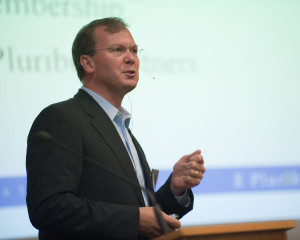Three Ways to Create a Connected Culture

An interview with Michael Lee Stallard, president and co-founder of E Pluribus Partners and author of the book, Fired Up or Burned Out
As business leaders, we can spot a burned-out employee from a mile away. And it’s easy to pick out the employees who are fired up about their work, too. To be able to do our jobs — to increase our companies’ revenues, productivity and creativity — we need our employees to be fired up about our company’s goals and about how their work fits in.
We all know that. But do we know how to move people from burned out to fired up? Not long ago, I caught up with Michael Lee Stallard, author of the book, Fired Up or Burned Out. Michael is president and co-founder of E Pluribus Partners, and we first met when he spoke to the annual Retailing Summit at Texas A&M University’s Mays Business School.
Michael and I talked about the importance of positive work environments in greater depth.
Over the course of several years, Michael has observed employee and leadership interactions and conducted studies of leaders and their businesses. He noticed that people seemed to come into an organization fired up, then get burned out after being part of their work cultures over time. Studies show that seven in 10 Americans are not engaged in their jobs. Keeping employees’ inner flames burning bright should be one of company leaders’ top priorities.
“Because so few individuals are thriving in organizations, it follows that organizations are wasting much of their potential,” he said in his book. “Employees in an organization with a high degree of connection are more engaged, more productive in their jobs and less likely to leave the organization for a competitor. Connection transforms a dog-eat-dog environment into a sled dog team that pulls together.”
Some of the most successful companies, such as The Ritz-Carlton Hotel Company, Starbucks and jetBlue, have leaders who are dedicated to creating positive environments within their organizations. However, even though there is proof that committed workers produce better results, many CEOs are still not investing time in connecting with their employees – the people who are directly responsible for representing the brand.
“Most leaders are dominated by the left brain, which causes them to view actions that improve employee commitment as ineffective. So, they are convinced that investing time in soft issues is only smart if positive, tangible effects on people and organizations are immediately apparent,” said Stallard. He counsels leaders to recognize how important it is to be intentional about creating connection cultures within their businesses.
Executives who want to create a connection culture should focus on three principles of leadership and communication:
Articulate the VISION. Articulate a shared purpose or set of beliefs that will unite and motivate people.
Acknowledge employees’ VALUE. Understand employees’ needs, appreciate and acknowledge their contributions, and help them reach their potential.
Give employees a VOICE. Seek out and consider employees’ ideas.
Leaders can apply these principles through regular one-on-one meetings with employees. For example, I once encouraged a healthcare CEO, who often said he couldn’t find time, to conduct one-on-one meetings with his direct reports. When this exec did make time to meet with staff, he discovered his CFO was contemplating leaving the company. By making regular meetings a priority, the CEO was able to successfully connect with his employees and, in this case, retain a valuable asset, the CFO.
Strong leaders know that positive business results come from attending to not only clients and shareholders but also to their employees.
 Becky Powell-Schwartz, Founder & CEO
Becky Powell-Schwartz, Founder & CEO 
